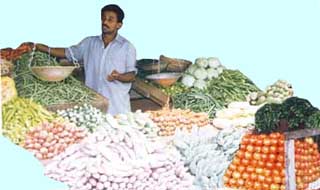 |

31st January 1999 |
News/Comment| Editorial/Opinion| Business| Sports | Mirror Magazine |
Vegetable prices are going up again. Reason? Bad weatherWhat's labai?By Chamintha ThilakarathnaThe weather is bad. Farmers and officials point their fingers at the sky. Yes, the weather is bad and vegetable prices are going up.The prices of vegetables displayed at stalls leave people with one big question. How can the man on the street afford to eat his rice & curry? At the Pettah and Maradana markets, people looked lost among the prices
of proud brinjals and carrots. "I find it difficult to afford even the basic food items like rice, with prices going up as high as Rs.100 for onions or Rs.60 a kilo of beetroot," said S. Fernando from Wattala. Newly married, she struggled to decide what items to buy at a resonable price at the market. Ms. Fernando is not the only one, many expressed similar sentiments. Ironically on the other hand, vendors too seem to be equally baffled. They said that the prices had arisen suddenly, from a fairly reasonable low in November/December. K.A. Gunasiri who has been keeping an onion stall at the Maradana market for the last eight years said that the prices were so high that sometimes they themselves were not sure whether to buy the usual quantities from the wholesalers. Tomatoes, dried chillies, red onions, and rice had topped the price list. Prices of red onions had arisen to Rs.132 per kilo and dried chillies to an average of Rs.155 per kilo, tomatoes were priced between Rs.90-100. Some said these were the highest that has been recorded in ten years. Carrot was at Rs.48, beans at Rs. 48, brinjals was Rs.40, leeks, at Rs.40, beetroot at Rs. 60, capsicums Rs.60 (all kilos) while a coconut averaged between Rs.13-15. Prices of rice showed no relief. Red rice was priced at Rs. 34 and samba at Rs.36. According to Agricultural Research and Training Institute reports, in the same week last year, price of rice varied from Rs.20-31 but last week, the prices varied from Rs.28-37. There was almost a ten-rupee increase. Samba has increased by 10% since last year and Koranadu by 15%, ARTI officials said. One reason for the high price of rice is the 35% import duty which was imposed recently and this duty tax has almost stopped imports. Sri Lanka depends on 10-15% of Indian rice imports. Officials said that no import of rice had been recorded last week. The Agricultural Ministry has so far not decided whether they want to withdraw the high duty on rice imports. Agriculture Minister D.M.Jayaratna earlier told The Sunday Times that rice could be imported but could be put into the market only in a case of shortage in the local market. The move was taken in order to encourage local farmers. Unfortunately the plan backfired. Rains spoilt local crops, but traders did not have imported stocks. "Tomatoes and dried chillies have been affected by the rainfall. "Some tomatoes were spoilt due to heavy showers and similarly, red chilli crops have been badly affected," said a senior official at the Agricultural Ministry . According to ARTI officials, high quality dried chillies were priced between Rs.150-175 and low quality between Rs.145 -165 last week. Dried chillies have increased by well above 70% since last year. For products such as dried chillies, tomatoes and red onions there seems
to be no hope but a good weather change.
Rain rain go awayIt seems that global weather changes are affecting our daily plate of rice. Unless weather patterns improve there is very little chance of prices going down, officials say.The Sunday Times contacted the Meteorological Department to find out if the weather shows signs of improvement in the weeks to come. "In January there was quite unusual weather for this part of the region. The periods of bad weather was because of the 'convergence zone' which usually hovers to the east of Sri Lanka was right above us this time. At the same time, upper air disturbances also added to the bad weather condition," Meteorological Chief Dr. A.W. Mohottala said. Weather changes have been experienced for the last few months in the region. Unexpected floods and draught have affected crops in India, Sri Lanka as well as other SAARC countries. Dr. Mohottala says that the situation is expected to brighten although he cannot assure that the weather would improve to help farmers. However Agricultural Ministry officials say prices could by and large come down in the near future with more imports. But they too warned that if the weather did not improve the situation could worsen as exports from India too have been restricted due to flooding in the farming areas. |
||
 |
More Plus * From the day you were bornů
Front Page| News/Comment| Editorial/Opinion| Business| Sports | Mirror Magazine |
|
 |
|
|
